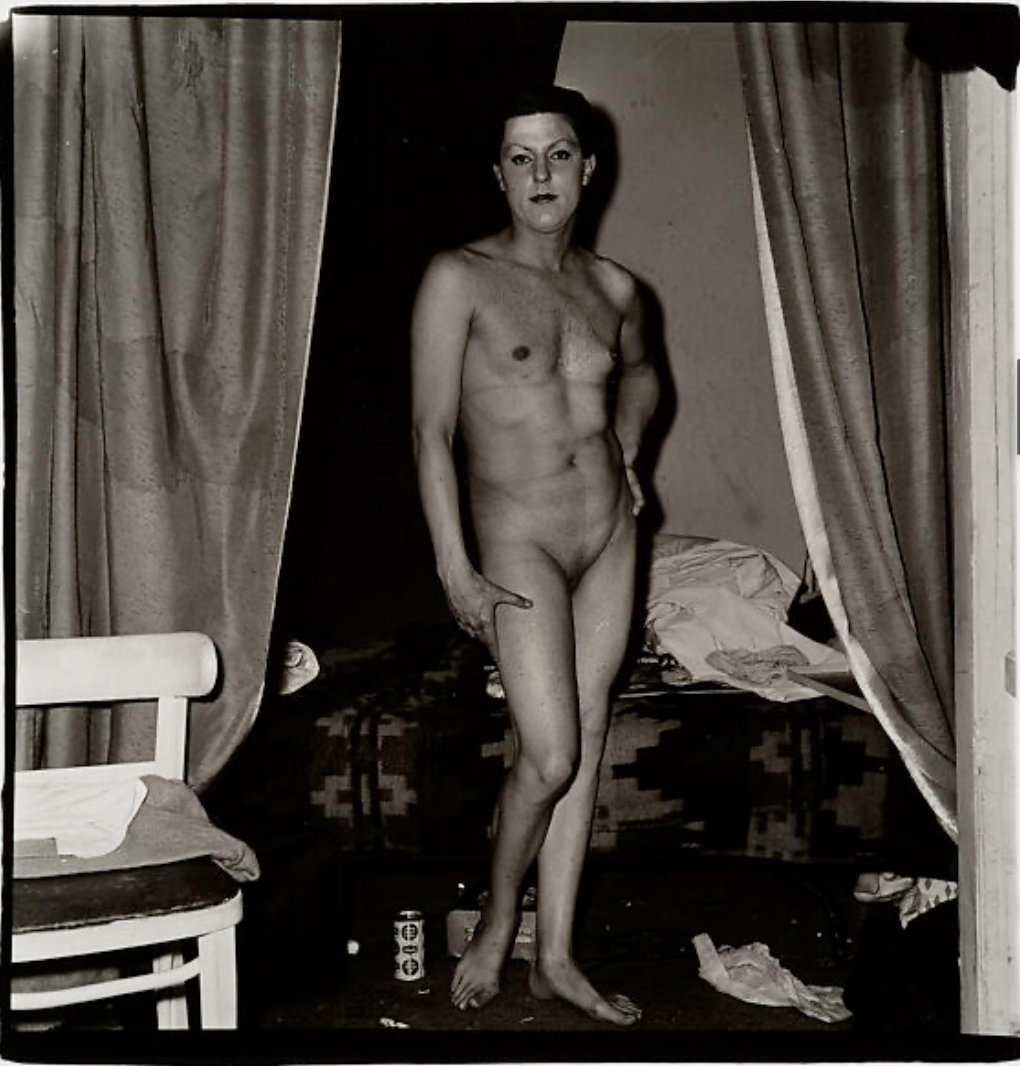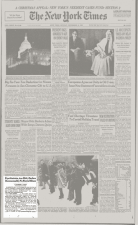Normalization of LGBTQ people-work of Diane Arbus
Created by Long-Yang Li on Mon, 04/01/2024 - 01:22
This timeline provides a sociohistorical context for Diane Arbus' 1968 A Naked Woman Being a Man.
Arbus, Diane. Photo of A naked man being a woman, N.Y.C. 1968.
https://www.metmuseum.org/art/collection/search/288914. Accessed 24
February 2024.
Timeline
Chronological table
| Date | Event | Created by | Associated Places | |
|---|---|---|---|---|
| Aug 1966 to Aug 1966 |
Compton’s Cafeteria Riot
A late night in August 1966, a restaurant called Gene Compton’s Cafeteria, which is a very popular meeting place for transgender and other gender queer people, was raided by police officers in aim to humiliate those LGBTQ members. One member of the group decided to “fight back” and this ended up becoming a two days long riot between the LGBTQ community and polices. Events like this has ignited people’s rage towards discrimination against the LGBTQ community, and this is what makes this photo so provoking. The subject of this photo is clearly appearing to be a gender queer, and such bold display of her transgendered body in a sensitive time when homosexuality was still diagnosed as a mental illness was no doubt a tremendously brave act, almost like an oppositional gaze and a protest to discriminative event like such. Such spotlighted display of individuals from all populations was also what Diane Arbus was known for—subjects that ranged from strippers and nudist all the way to middle class people and famous performers. |
Long-Yang Li | ||
| 28 Feb 1967 to 7 May 1967 |
New Documents
The “New Documents” was a photograhy exhibition hosted by the Museum of Modern Art in New York. This exhibition included the works from three photographers including Diane Arbus, with a theme of documentary photography—yet the works that were shown in the exhibition had almost revolutionized people’s way on viewing documentary photos—the photographs were not mere recordings from camera lens but revealed a sense of provocation that was on purposely captured by these photographers. For example, Diane Arbus’ photo had expressed her view on the so called “societal frailties”, people of minorities who are living on the edge of the society, never seen on main-stream media were being put on spotlight and presented to the public. Such purposeful depiction of conflicting individuals echoed throughout her photographs, including A Nake Man Being A Woman. And this unique presentation of realistic photographs that are not purposely set in a decorated scene to present it through lens of photoshoped beauty is also what makes her one of the most influential photographers that pionnered an aspect of modern photography. |
Long-Yang Li | ||
| 15 Dec 1973 to 15 Dec 1973 |
Removal of Homosexuality from DSM
December 15, 1973 was a memorable day as this is the day when the American Psychology Association announced that they have removed homosexuality as a mental illness from the DSM. Such declaration had finally removed a humiliating and pathologizing tag that has been put on people of the LGBTQ population for centuries. And such accomplishment would be impossible for the countless work people had put into. The photographs of Diane Arbus, though she personally had not counted herself as an acitive supporter of the LGBTQ community, has indirectly pushed this problem into the publics’ view. That is, though her photographs were not taken on purposely as a sign of protest against discriminations on the LGBTQ community, her appreciation and empathy that was shown through the photographs she took on such people of transgender and homosexualness has no doubt increased the exposure on these “borderline people” to the main streams’ view. Simply by putting portraits of these people on public exhibitions without the purpose of objectfying/humiliating them would already be a great contribution towards depathologizing their identities.
The reason that I offered that background concerning those three events is because it helps me to explain what A Naked Man Being a Woman was doing socially when Daine Arbus created it. That is, when this photo was taken in 1968, it was right at the time when homosexuality was an extremely sensitive and controversial topic. We can see this from the Riot in Compton’s Cafeteria in 1966, in which this popular queer-gathering place was purposely harrassed by polices until one of them decided to fight back. Events like this were happening very frequently at that time, since the societal perception of homosexuality at that time was still that it is an abnormal and degenerating illness, even a shameful crime. Yet as controversial and risky as it may be, Diane Arbus still filmed minorities like them and presented her works in 1967 in the New Documents exhibition in the Museum of Modern Art. In this exhibition we are not only able to see these societal-borderline people being put into the spotlight, but we can also see her unique way of presenting them—She almost took the pictures as if they were screenshots from a documentary. That is, she never tries to manipulate the settings or environment of her photos. Instead, she likes taking pictures of her subjects in their homes, presenting them in the most natural and realistic manner. Such presentation is not only original but it is also incredibly powerful, as it gives the audience no place to interpret or hide away from the picture—they are who they are, just being there. This successful exhibition not only end up making her one of the most influential photographers on modern photography, but it also brought the attention that was needed for the LGBTQ community. Her path never stopped after the exhibition, just one year after in 1968, A Naked Man Being a Woman was taken and added to her masterworks. This blantant depiction of a naked transgender man staring at the audience, the oppositional gaze, and the confidence has made this picture so provoking, confronting and yet such a great representation of Arbus’ works. By simply documenting photographies of such controversial individuals, she was able to create an obtrusive voice of the LGBTQ community that is loud enough to disturb every audience. Then, five years after in December, 1973 comes the historical moment of homosexuality being removed from the DSM as being a mental illness. Is this profound change caused by her work? It can’t be determined. However, there is definitely a correlation between aritists like her who presented works of the LGBTQ community to the public, to the success of recognizing them as being normal. That is, intentionally or not, simply the frequent presentation of LGBTQ people to the public itself had normalized their very existence, almost like a desensitization process in behavioral psychology.
|
Long-Yang Li |



